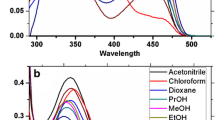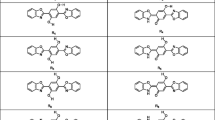Abstract
Hanson et al. [Org. Lett., 2011] reported the absorption and emission spectrum of 5,6-dichloro-1,3-bis(2-pyridylimino)-4,7-dihydroxyisoindole but the excited-state intramolecular proton transfer (ESIPT) process was not investigated. The photo-physical behaviour of 5,6-dichloro-1,3-bis(2-pyridylimino)-4,7-dihydroxyisoindole was studied using the density functional theory (DFT) and time-dependent density functional theory (TD-DFT). The functional used was B3LYP and 6-31G(d) was the basis set for all the atoms. All the ten tautomers were studied for the absorption and emission properties. It is found that the tautomer where hydroxyl groups are syn to nitrogen of isoindoline ring is most stable and thus, responsible for the ESIPT process. The computed absorption and emission values of tautomers using TD-DFT are in good agreement with those obtained experimentally.




Similar content being viewed by others
References
Kasha BYM (1950) Characterization of electronic transitions in complex molecules. Discuss Faraday Soc 9:14–19. doi:10.1039/df9500900014
Ireland JF, Wyatt PAH (1976) Acid-Base Properties of Electronically Excited States of Organic Molecules. Adv Phys Org Chem 12:131
Forster (1949) Fluoreszenzspektrum und Wasserstoffionen-konzentration. Naturwissenschaften 36:186–187. doi:10.1007/BF00626582
Weller A (1961) A. Prog React Kinet
Vander Donckt (1970) Prog React Kinet
Schulman, SG (1970) Influence of ph in fluorescence and phosphorescence spectrometric analysis *. 17:607–616.
Kelly RNSS (1988) In Molecular LuminescenceSpectroscopy; Methods and Applications. Wiley -Interscience, New York
Smith TP, Zaklika KA, Thakur K, Barbara PF (1991) Excited state intramolecular proton transfer in 1-(acylamino)anthraquinones. J Am Chem Soc 113:4035–4036. doi:10.1021/ja00010a079
Martinez, M. L.; Studer, S. L.;Chou P. (1991) Direct evidence of the excited state intramolecular proton transfer in 5-hydroxyflavone. 113:5881–5883.
Martinez ML, Studer SL, Chou PT (1990) Direct evidence of the triplet-state origin of the slow reverse proton transfer reaction of 3-hydroxyflavone. J Am Chem Soc 112:2427–2429. doi:10.1021/ja00162a058
Catalan J, Fabero F, Soledad Guijarro M, et al. (1990) Photoinduced intramolecular proton transfer as the mechanism of ultraviolet stabilizers: a reappraisal. J Am Chem Soc 112:747–759. doi:10.1021/ja00158a039
Brinn IM, Carvalho CEM, Heisel F, Miehe JA (1991) Excited-state acidity of bifunctional molecules. 2. Picosecond emission of 5-(2-hydroxyphenyl)-3-phenyl-1,2,4-oxadiazole. J Phys Chem 95:6540–6544. doi:10.1021/j100170a031
Chou PT, Matinez ML, Cooper WC (1992) Direct evidence of excited-state intramolecular proton transfer in 2′-hydroxychalcone and photooxygenation forming 3-hydroxyflavone. J Am Chem Soc 114:4943–4944. doi:10.1021/ja00038a091
Peteanu L a, Mathie R a (1992) Resonance raman intensity analysis of the excited-state proton transfer in. 96:6910–6916.
Chou P-T, Martinez ML, Cooper WC, et al. (1992) Monohydrate catalysis of excited-state double-proton transfer in 7-azaindole. J Phys Chem 96:5203–5205. doi:10.1021/j100192a002
Lan X, Yang D, Sui X, Wang D (2013) Time-dependent density functional theory (TD-DFT) study on the excited-state intramolecular proton transfer (ESIPT) in 2-hydroxybenzoyl compounds: Significance of the intramolecular hydrogen bonding. Spectrochim Acta - Part A Mol Biomol Spectrosc 102:281–285. doi:10.1016/j.saa.2012.10.017
Zhao J, Ji S, Chen Y, et al. (2012) Excited state intramolecular proton transfer (ESIPT): from principal photophysics to the development of new chromophores and applications in fluorescent molecular probes and luminescent materials. Phys Chem Chem Phys 14:8803–8817. doi:10.1039/c2cp23144a
Chen C-L, Lin C-W, Hsieh C-C, et al. (2008) Dual excited-state intramolecular proton transfer reaction in 3-hydroxy-2-(pyridin-2-yl)-4H-chromen-4-one. J Phys Chem A 113:205–214. doi:10.1021/jp809072a
Chen K-Y, Hsieh C-C, Cheng Y-M, et al. (2006) Extensive spectral tuning of the proton transfer emission from 550 to 675 nm via a rational derivatization of 10-hydroxybenzo[h]quinoline. Chem Commun:4395–4397. doi:10.1039/B610274C
Chen K-Y, Cheng Y-M, Lai C-H, et al. (2007) Ortho Green Fluorescence Protein Synthetic Chromophore; Excited-State Intramolecular Proton Transfer via a Seven-Membered-Ring Hydrogen-Bonding System. J Am Chem Soc 129:4534–4535. doi:10.1021/ja070880i
Schwartz BJ, Peteanu LA, Harris CB (1992) Direct observation of fast proton transfer: femtosecond photophysics of 3-hydroxyflavone. J Phys Chem 96:3591–3598. doi:10.1021/j100188a009
Kasha M (1986) Proton-transfer Spectroscopy. J Chem Soc Faraday Trans 82:2379–2392
Balzani V, Scandola F (1991) Supramolecular Photochemistry. Ellis Horwood
Stephan JS, Rodríguez CR, Grellmann KH, Zachariasse KA (1994) Flash-photolysis of 2-(2′-hydroxyphenyl)-3-H-indole. Ground-state keto-enol tautomerization by mutual hydrogen exchange and by proton catalysis Chem Phys 186:435–446. doi:10.1016/0301-0104(94)01624-0
Jana S, Dalapati S, Guchhait N (2012) Proton Transfer Assisted Charge Transfer Phenomena in Photochromic Schi ff Bases and E ff ect of − NEt 2 Groups to the Anil Schi ff Bases. J Phys Chem A 116:10948
Kwon JE, Park SY (2011) Advanced organic optoelectronic materials: Harnessing excited-state intramolecular proton transfer (ESIPT) process. Adv Mater 23:3615–3642. doi:10.1002/adma.201102046
Kim T-I, Kang HJ, Han G, et al. (2009) A highly selective fluorescent ESIPT probe for the dual specificity phosphatase MKP-6. Chem Commun (Camb) 2:5895–5897. doi:10.1039/b911145j
Xu Y, Pang Y (2010) Zinc binding-induced near-IR emission from excited-state intramolecular proton transfer of a bis ( benzoxazole ) derivative w. Chem Commun 46:4070–4072. doi:10.1039/c003230a
Dong D, Jing X, Zhang X, et al. (2012) Gadolinium(III)-fluorescein complex as a dual modal probe for MRI and fluorescence zinc sensing. Tetrahedron 68:306–310. doi:10.1016/j.tet.2011.10.034
Yan L, Ye Z, Peng C, Zhang S (2012) A new perylene diimide-based fluorescent chemosensor for selective detection of ATP in aqueous solution. Tetrahedron 68:2725–2727. doi:10.1016/j.tet.2012.01.028
Chen W, Wright BD, Pang Y (2012) Rational design of a NIR-emitting Pd(ii) sensor via oxidative cyclization to form a benzoxazole ring. Chem Commun 48:3824. doi:10.1039/c2cc30240c
Sun W, Li S, Hu R, et al. (2009) Understanding solvent effects on luminescent properties of a triple fluorescent ESIPT compound and application for white light emission. J Phys Chem A 113:5888–5895. doi:10.1021/jp900688h
Park S, Ji EK, Se HK, et al. (2009) A white-light-emitting molecule: Frustrated energy transfer between constituent emitting centers. J Am Chem Soc 131:14043–14049. doi:10.1021/ja902533f
Giordano L, Shvadchak VV, Fauerbach J a, et al. (2012) Highly solvatochromic 7-aryl-3-hydroxychromones. J Phys Chem Lett 3:1011–1016. doi:10.1021/jz3002019
Kim S, Park SY (2003) Photochemically gated protonation effected by intramolecular hydrogen bonding: towards stable fluorescence imaging in polymer films. Adv Mater 15:1341–1344. doi:10.1002/adma.200305050
Kim S, Park SY, Yoshida I, et al. (2002) Amplified spontaneous emission from the film of poly(aryl ether) dendrimer encapsulating excited-state intramolecular proton transfer dye. J Phys Chem B 106:9291–9294. doi:10.1021/jp021048x
Jayabharathi J, Thanikachalam V, Vennila M, Jayamoorthy K (2012) DFT based ESIPT process of luminescent chemosensor: Taft and Catalan solvatochromism. Spectrochim Acta - Part A Mol Biomol Spectrosc 95:589–595. doi:10.1016/j.saa.2012.04.056
Kim CH, Joo T (2009) Coherent excited state intramolecular proton transfer probed by time-resolved fluorescence. Phys Chem Chem Phys 11:10266–10269. doi:10.1039/b915768a
Nayak MK (2012) Synthesis, characterization and optical properties of aryl and diaryl substituted phenanthroimidazoles. J Photochem Photobiol A Chem 241:26–37. doi:10.1016/j.jphotochem.2012.05.018
Mitra S, Singh TS, Mandal a, Mukherjee S (2007) Experimental and computational study on photophysical properties of substituted o-hydroxy acetophenone derivatives: Intramolecular proton transfer and solvent effect. Chem Phys 342:309–317. doi:10.1016/j.chemphys.2007.10.017
Tomasi J, Mennucci B, Cammi R (2005) Quantum mechanical continuum solvation models. Chem Rev 105:2999–3093. doi:10.1021/cr9904009
Hsieh C-C, Jiang C-M, Chou P-T (2010) Recent experimental advances on excited-state intramolecular proton coupled electron transfer reaction. Acc Chem Res 43:1364–1374. doi:10.1021/ar1000499
Dennison SM, Guharay J, Sengupta PK (1999) Excited-state intramolecular proton transfer (ESIPT) and charge transfer (CT) fluorescence probe for model membranes. Spectrochim Acta Part A Mol Biomol Spectrosc 55:1127–1132. doi:10.1016/S1386-1425(99)00013-X
Li G-Y, Chu T (2011) TD-DFT study on fluoride-sensing mechanism of 2-(2′-phenylureaphenyl)benzoxazole: The way to inhibit the ESIPT process. Phys Chem Chem Phys 13:20766. doi:10.1039/c1cp21470e
Li G-Y, Zhao G-J, Han K-L, He G-Z (2011) A TD-DFT study on the cyanide-chemosensing mechanism of 8-formyl-7-hydroxycoumarin. J Comput Chem 32:668–674. doi:10.1002/jcc.21651
Guang-Yue Li, Guang-Jiu Zhao, Yu-Hui Liu, ke-Li Han G-ZH (2010) TD-DFT Study on the Sensing Mechanism of a Fluorescent Chemosensor for Fluoride: Excited-State Proton Transfer. J Comput Chem 31:1759.
Hanson K, Patel N, Whited MT, et al. (2011) Substituted 1,3-bis(imino)isoindole diols: A new class of proton transfer dyes. Org Lett 13:1598–1601. doi:10.1021/ol103106m
Treutler O, Ahlrichs R (1995) Efficient molecular numerical integration schemes. J Chem Phys 102:346–354
Becke AD (1993) A new mixing of Hartree–Fock and local density-functional theories. J Chem Phys 98:1372–1377
Lee C, Yang W, Parr RG (1988) Development of the Colle-Salvetti correlation-energy formula into a functional of the electron density. Phys Rev B 37:785–789
Casida ME, Jamorski C, Casida KC, Salahub DR (1998) Molecular excitation energies to high-lying bound states from time-dependentdensity- functionalresponsetheory: Characterizationand correctionofthetime-dependentlocal densityapproximation ionization threshold Mark. J Chem Phys 108:4439. doi:10.1063/1.475855
Santra M, Moon H, Park MH, et al. (2012) Dramatic substituent effects on the photoluminescence of boron complexes of 2-(benzothiazol-2-yl)phenols. Chem – A Eur J 18:9886–9893. doi:10.1002/chem.201200726
Li H, Niu L, Xu X, et al. (2011) A comprehensive therotical investigation of intramolecular proton transfer in the excited states for some newly-designed diphenylethylene derivatives bearing 2-(2-Hydroxy-Phenyl)-Benzotriazole part. J Fluoresc 21:1721–1728. doi:10.1007/s10895-011-0867-6
Hehre WJ, Radom L, Schleyer P v, P R (1986) Initio Molecular Orbital Theory. Wiley -Interscience, New York
Bauernschmitt R, Ahlrichs R (1996) Treatment of electronic excitations within the adiabatic approximation of time dependent density functional theory. Chem Phys Lett 256:454–464. doi:10.1016/0009-2614(96)00440-X
Filipp Furche∗ and Dmitrij Rappoport (2005) Density functional methods for excited states: equilibrium structure and electronic spectra. Elsevier, Amsterdam
Lakowicz JR (1999) Principles of fluorescence spectroscopy, 2nd edn. Springer, New York
Valeur B (2001) Molecular fluorescence: principles andApplications. Wiley –VCH, Weinheim
Cossi M, Barone V, Cammi R, Tomasi J (1996) Ab initio study of solvated molecules: a new implementation of the polarizable continuum model. Chem Phys Lett 255:327–335. doi:10.1016/0009-2614(96)00349-1
Frisch MJ, Trucks GW, Schlegel HB, Scuseria GE, Robb MA, Cheeseman JR, Scalmani G, Barone V, Mennucci B, Petersson GA, Nakatsuji HCM, Li X, Hratchian HP, Izmaylov AF, Bloino J, Zheng G, Sonnenberg JL, Fox DJ et al. (2010) Gaussian 09 revision C01, Gaussian Inc, Wallingford
Legault CY (2009) CYLview, 1.0b; Universit_e de Sherbrooke. http://www.cylview.org. Accessed 19 Jan 2016
Acknowledgments
SK is thankful to UGC for giving study leave (FIP) and SIES college for sanctioning the study leave. PR and LR acknowledge facilities from the University of Mauritius.
Author information
Authors and Affiliations
Corresponding authors
Electronic Supplementary Material
ESM 1
(DOCX 1129 kb)
Rights and permissions
About this article
Cite this article
Kataria, S., Rhyman, L., Ramasami, P. et al. Comprehensive DFT and TD-DFT Studies on the Photophysical Properties of 5,6-Dichloro-1,3-Bis(2-Pyridylimino)-4,7-Dihydroxyisoindole: A New Class of ESIPT Fluorophore. J Fluoresc 26, 1805–1812 (2016). https://doi.org/10.1007/s10895-016-1872-6
Received:
Accepted:
Published:
Issue Date:
DOI: https://doi.org/10.1007/s10895-016-1872-6




